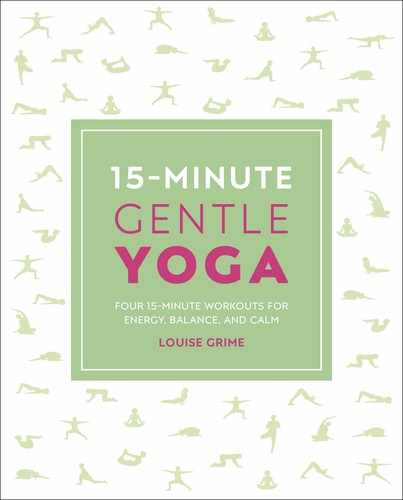
Introduction
Welcome to yoga, whether you are trying it out to feel more fit and more
flexible, or to de-stress and energize your mind and body. As you practice,
you may find that yoga becomes a way of life and you start to approach
every aspect of your day with an inquiring, balanced yoga mind-set.
When you embrace yoga, it becomes much more
than what you do on the mat—it begins to filter into
your way of thinking and interacting with others. As
the postures and breathing practices make you feel
bright and alive, so your self-confidence and energy
levels soar; as you begin to notice where in the body
you hold tension, and free it up by stretching and
breathing more effectively, so you begin to become
less stressed in your mind, too, and more able to
appreciate life from different perspectives—just as
yoga postures ask you to see the world upside
down, backward, or sideways. As your physical
balance improves, so does your ability to adopt a
more measured approach to decision making and
problem solving, enhancing every aspect of life, from
your relationships at home and work to the way in
which you do business. Above all, yoking together
your body and mind with the single focus of a yoga
posture makes every part of you feel more
harmonious.
WHAT IS HATHA YOGA?
In the West, we tend to think of yoga as a system
of physical exercises (known as asanas) and
breathing techniques (known as pranayama).
But this type of yoga—hatha yoga—is simply
one route toward the ultimate aim of yoga, which
is to feel so profoundly at peace within that we
become aware of a connection with everything
else in the universe. In India, where yoga originated
many thousands of years ago, people follow other
yoga paths to the same end-state of harmonious
union: bhakti yoga, the path of religious worship;
karma yoga, doing selfless service for others
(Mother Teresa epitomizes this path of yoga);
jnana yoga, studying yogic philosophy; and raja
yoga, meditation. Each of these yoga paths suits
a different personality type. You have probably
turned to hatha yoga, the physical aspect of yoga,
because, like many of us in the West, you are
interested in boosting your health and well-being,
and would like to achieve a little more inner peace.
As you clean and loosen out your body with its
postures, you taste the lightness of being that
is hatha yoga.
WEAVING YOGA INTO YOUR LIFE
•
Try to joyfully accept your current
physical limitations. Learn to work with stiff
hamstrings or tight shoulders, rather than
struggle against them, and you’ll become
more adept more quickly.
•
Don’t be dispirited when you first begin
yoga. Keep a sense of humor, and be kind
to your body, and the knots in your mind
will also start to unwind.
•
Be patient and watch your breath rather
than pushing yourself to compete, and soon
you will experience the bliss of yoga.
US_010-011_Intro.indd 10 21/06/2019 11:12

10/11
FINDING A TEACHER
When you practice yoga with a teacher, you gain
expert advice, as well as invaluable hands-on
adjustments. Working with a teacher also helps you
gain the confidence to progress to more difficult
poses and to work with breathing and meditation
techniques. If you attend a regular yoga class, you
will also build up a network of supportive fellow
students to help you maintain motivation.
But how do you find a teacher to suit you, and
a style of yoga from the many confusing options on
offer? The best way is to visit a yoga center or gym
close to your home or workplace. You can also look
for local classes on notice boards in your doctors’
office and library, for example. Ask for a list of
classes and a description of the style of class if it is
not a general “hatha yoga” class (which may draw on
a mix of styles—hatha yoga can be taught in myriad
ways). Iyengar yoga, the most practiced form of yoga
across the globe, focuses on alignment and
precision in the physical postures using props
such as blocks and belts, and offers a sound
foundation for beginners. If you enjoy fast-moving
exercise, you might try ashtanga vinyasa classes,
which teach a seamless flow of postures (classes
might be called vinyasa flow, dynamic, or power
yoga). If you prefer a more esoteric approach that
includes chanting and a focus on breathing,
meditation, and energy-raising techniques, look
out for Sivananda or Kundalini yoga. If you have
an ongoing health problem, try therapeutic
Iyengar yoga or viniyoga, which tailors sequences
of poses to suit your particular healing needs.
If you are pregnant or postpartum, find a class
especially geared for you. What’s important is that
you find the teacher inspiring and approachable.
In the end this matters more than the type of
yoga you follow.
A teacher offers hands-on adjustments while you hold
a pose, which helps you relax effortlessly into the posture
and to let go of held-in tension.
US_010-011_Intro.indd 11 21/06/2019 11:12
..................Content has been hidden....................
You can't read the all page of ebook, please click here login for view all page.
